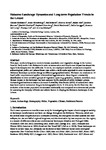Holocene Landscape Dynamics and Long-term Population Trends in the Levant
| dc.contributor.author | Palmisano, A | |
| dc.contributor.author | Woodbridge-Fisher, J | |
| dc.contributor.author | Roberts, C Neil | |
| dc.contributor.author | Bevan, A | |
| dc.contributor.author | Fyfe, R | |
| dc.contributor.author | Shennan, S | |
| dc.contributor.author | Cheddadi, R | |
| dc.contributor.author | Greenberg, R | |
| dc.contributor.author | Kaniewski, D | |
| dc.contributor.author | Langgut, D | |
| dc.contributor.author | Leroy, SAG | |
| dc.contributor.author | Litt, T | |
| dc.contributor.author | Miebach, A | |
| dc.date.accessioned | 2018-10-17T21:33:45Z | |
| dc.date.issued | 2019-05-01 | |
| dc.identifier.issn | 0959-6836 | |
| dc.identifier.issn | 1477-0911 | |
| dc.identifier.uri | http://hdl.handle.net/10026.1/12578 | |
| dc.description.abstract |
<jats:p>This paper explores long-term trends in human population and vegetation change in the Levant from the early to the late Holocene in order to assess when and how human impact has shaped the region’s landscapes over the millennia. To do so, we employed multiple proxies and compared archaeological, pollen and palaeoclimate data within a multi-scalar approach in order to assess how Holocene landscape dynamics change at different geographical scales. We based our analysis on 14 fossil pollen sequences and applied a hierarchical agglomerative clustering and community classification in order to define groups of vegetation types (e.g. grassland, wetland, woodland, etc.). Human impact on the landscape has been assessed by the analysis of pollen indicator groups. Archaeological settlement data and Summed Probability Distribution (SPD) of radiocarbon dates have been used to reconstruct long-term demographic trends. In this study, for the first time, the evolution of the human population is estimated statistically and compared with environmental proxies for assessing the interplay of biotic and abiotic factors in shaping the Holocene landscapes in the Levant.</jats:p> | |
| dc.format.extent | 708-727 | |
| dc.language | en | |
| dc.language.iso | en | |
| dc.publisher | SAGE Publications | |
| dc.subject | archaeology | |
| dc.subject | climate | |
| dc.subject | demography | |
| dc.subject | Levant | |
| dc.subject | pollen | |
| dc.subject | settlement patterns | |
| dc.subject | vegetation | |
| dc.title | Holocene Landscape Dynamics and Long-term Population Trends in the Levant | |
| dc.type | journal-article | |
| dc.type | Journal Article | |
| plymouth.author-url | https://www.webofscience.com/api/gateway?GWVersion=2&SrcApp=PARTNER_APP&SrcAuth=LinksAMR&KeyUT=WOS:000468293200002&DestLinkType=FullRecord&DestApp=ALL_WOS&UsrCustomerID=11bb513d99f797142bcfeffcc58ea008 | |
| plymouth.issue | 5 | |
| plymouth.volume | 29 | |
| plymouth.publication-status | Published | |
| plymouth.journal | The Holocene | |
| dc.identifier.doi | 10.1177/0959683619826642 | |
| plymouth.organisational-group | /Plymouth | |
| plymouth.organisational-group | /Plymouth/Admin Group - REF | |
| plymouth.organisational-group | /Plymouth/Admin Group - REF/REF Admin Group - FoSE | |
| plymouth.organisational-group | /Plymouth/Faculty of Science and Engineering | |
| plymouth.organisational-group | /Plymouth/Faculty of Science and Engineering/School of Geography, Earth and Environmental Sciences | |
| plymouth.organisational-group | /Plymouth/REF 2021 Researchers by UoA | |
| plymouth.organisational-group | /Plymouth/REF 2021 Researchers by UoA/UoA14 Geography and Environmental Studies | |
| plymouth.organisational-group | /Plymouth/Research Groups | |
| plymouth.organisational-group | /Plymouth/Research Groups/Centre for Research in Environment and Society (CeRES) | |
| plymouth.organisational-group | /Plymouth/Research Groups/Centre for Research in Environment and Society (CeRES)/CeRES (Reporting) | |
| plymouth.organisational-group | /Plymouth/Research Groups/Marine Institute | |
| plymouth.organisational-group | /Plymouth/Users by role | |
| plymouth.organisational-group | /Plymouth/Users by role/Academics | |
| dcterms.dateAccepted | 2018-10-16 | |
| dc.rights.embargodate | 2020-3-27 | |
| dc.identifier.eissn | 1477-0911 | |
| dc.rights.embargoperiod | Not known | |
| rioxxterms.versionofrecord | 10.1177/0959683619826642 | |
| rioxxterms.licenseref.uri | http://www.rioxx.net/licenses/all-rights-reserved | |
| rioxxterms.licenseref.startdate | 2019-05-01 | |
| rioxxterms.type | Journal Article/Review |


